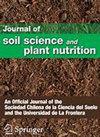益生元:改善植物生长、土壤健康和碳固存的解决方案?
IF 3.1
3区 农林科学
引用次数: 0
摘要
土壤肥力和生产力受到开发和退化过程的严重影响。这些威胁,再加上人口增长和气候变化,迫使我们寻求创新的农业生态解决方案。益生元是一种土壤生物刺激剂,用于改善土壤条件和植物生长,并可能在碳(C)固存中发挥作用。研究了两种商业益生元K1®和NUTRIGEO L®(分别称为SPK和SPN)在玉米种植的农业土壤上与未处理土壤或对照土壤(SP)相比的效果。分析在两个收获日期进行:施用益生元后3周(D1)和10周(D2)。测定植物生长参数和土壤特征,重点测定土壤有机质、土壤细菌和真菌群落以及植物根系菌根化。在理化参数方面,两种益生元处理均提高了土壤电导率、阳离子交换容量和可溶性磷(P),降低了硝酸盐。与此同时,SPN处理在D2点对钙(Ca)和硼(B)等特定阳离子矿物的提高有显著性作用。在微生物水平上,每一种益生元都引起了本地细菌和真菌群落丰度和多样性的独特变化,这在D2中很明显。同时,每种益生元处理均可招募到特定的微生物类群,如细菌中的Caulobacter、Sphingobium和Massilia, SPK真菌中的Mortierella globalpina和Schizothecium carpinicola,细菌中的Chitinophaga、Neobacillus和rhizzomicroum, SPN真菌中的Sordariomycetes和Mortierella minutissima。这些生物标志物被鉴定为(a)腐养菌,(b)植物生长促进细菌和真菌,(c)菌丝内细菌,(d)内生和共生微生物群。这一结果反映在处理土壤中球囊素含量和菌根率的增加,特别是SPN处理。我们观察到,这些效应导致植物生物量增加(SPK和SPN分别增加19%和22.8%,根系干重分别增加47.8%和35.7%),土壤C含量增加(有机C增加8.4%,总C增加8.9%),特别是SPN处理。根据这些发现,在施用10周后使用益生元不仅通过改善土壤特征和塑造其原生微生物群落来促进植物生长,而且还显示出增强碳固存的潜力。本文章由计算机程序翻译,如有差异,请以英文原文为准。

Prebiotics: A Solution for Improving Plant Growth, Soil Health, and Carbon Sequestration?
Abstract Soil fertility and productivity are severely impacted by exploitation and degradation processes. These threats, coupled with population growth and climatic changes, compel us to search for innovative agroecological solutions. Prebiotics, a type of soil biostimulant, are used to enhance soil conditions and plant growth and may play a role in carbon (C) sequestration. Two commercial prebiotics, K1® and NUTRIGEO L® (referred to as SPK and SPN, respectively), were assessed for their effects on agricultural soil cultivated with Zea mays L., compared to untreated soil or control (SP). Analyses were performed at two harvesting dates: three weeks (D1) and ten weeks (D2) after the application of prebiotics. Plant growth parameters and soil characteristics were measured, focusing on soil organic matter, soil bacterial and fungal communities, and plant root mycorrhization. Regarding physicochemical parameters, both prebiotic treatments increased soil electrical conductivity, cation exchange capacity, and soluble phosphorus (P) while decreasing nitrates. Meanwhile, the SPN treatment was distinct in elevating specific cationic minerals, such as calcium (Ca) and boron (B), at D2. At the microbial level, each prebiotic induced a unique shift in the indigenous bacterial and fungal communities’ abundance and diversity, evident at D2. Simultaneously, specific microbial taxa were recruited by each prebiotic treatment, such as Caulobacter , Sphingobium , and Massilia from bacteria and Mortierella globalpina and Schizothecium carpinicola from fungi in SPK as well as Chitinophaga , Neobacillus , and Rhizomicrobium from bacteria and Sordariomycetes and Mortierella minutissima from fungi in SPN. These biomarkers were identified as (a) saprotrophs, (b) plant growth-promoting bacteria and fungi, (c) endohyphal bacteria, and (d) endophytic and symbiotic microbiota. This result was reflected in the increase in glomalin content and mycorrhization rate in the treated soils, especially by SPN. We observed that these effects led to an increase in plant biomass (shoots by 19% and 22.8% and roots by 47.8% and 35.7% dry weights for SPK and SPN, respectively) and contributed to an increase in soil C content (organic C by 8.4% and total C by 8.9%), particularly with SPN treatment. In light of these findings, the use of prebiotics ten weeks after application not only increased plant growth by improving soil characteristics and shaping its native microbial community but also demonstrated the potential to enhance C sequestration.
求助全文
通过发布文献求助,成功后即可免费获取论文全文。
去求助
来源期刊

Journal of Soil Science and Plant Nutrition
SOIL SCIENCE-
自引率
10.30%
发文量
331
期刊介绍:
The Journal of Soil Science and Plant Nutrition is an international, peer reviewed journal devoted to publishing original research findings in the areas of soil science, plant nutrition, agriculture and environmental science.
Soil sciences submissions may cover physics, chemistry, biology, microbiology, mineralogy, ecology, pedology, soil classification and amelioration.
Plant nutrition and agriculture submissions may include plant production, physiology and metabolism of plants, plant ecology, diversity and sustainability of agricultural systems, organic and inorganic fertilization in relation to their impact on yields, quality of plants and ecological systems, and agroecosystems studies.
Submissions covering soil degradation, environmental pollution, nature conservation, and environmental protection are also welcome.
The journal considers for publication original research articles, technical notes, short communication, and reviews (both voluntary and by invitation), and letters to the editor.
 求助内容:
求助内容: 应助结果提醒方式:
应助结果提醒方式:


